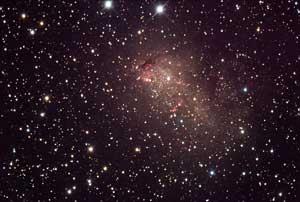
The galaxy IC 10 is an irregular dwarf galaxy about 1.8 million light-years from earth.
SAO astronomers have discovered in this galaxy the most massive known stellar black hole.
Black holes are irresistible sinks for matter and energy, so dense that not even light can escape from their gravitational clutches. Massive black holes contain millions to billions of solar masses of material, and reside at the centers of most galaxies, including our own Milky Way. Astronomers think these black holes develop during collisions between galaxies.
More ordinary-sized black holes -- "stellar black holes" -- form as remnants of the explosive deaths of massive stars, and are thought to contain not more than about twenty solar masses of material. Astronomers study black holes because they are fundamental to our understanding of gravity, because many form from stars whose evolutionary cycle is important to understand, and because they are thought to be relatively common objects in the universe.
Despite their reputation for being pitiless devourers of matter, black holes are often sources of powerful radiation. When the black hole has a companion star orbiting it, matter can form a disk of material as it falls close to the black hole from the companion, and that disk radiates brightly from the heat of friction, often in X-rays.
A team of nine astronomers led by SAO scientists Andrea Prestwich, Roy Kilgard, Andreas Zezas, and Steven Saar, used the Chandra X-ray Observatory and the NASA Swift X-ray satellite to discover a stellar black hole that is considerably more massive than the twenty sun masses the current theories can explain. At a mass of at least twenty-four solar masses (and perhaps as much as fifty-seven solar masses), it is the biggest stellar black hole ever found.
This giant black hole is located in the nearby galaxy IC 10 about 1.8 million light-years away. It was already suspected of being in a binary system with a companion star of about twenty solar masses. The astronomers discovered that the X-ray emission varied in intensity periodically, indicating that the object was indeed in a binary system, and furthermore one that was eclipsing, with the star crossing in front of the accretion disk and blocking our line-of-sight every 34.4 hours. Knowing the binary period and the mass of one star allows scientists to calculate the minimum mass of the other orbiting object, in this case the black hole.
Where this massive beast came from, however, is still a mystery. Since the theory of supernovae is thought to be reliable enough to exclude producing such a massive black hole, the astronomers suggest that the original remnant might have been smaller, but that it grew larger in time as material from its neighboring star fell into it. Both objects are thought to be about ten million years old, just about long enough for the current accretion rate inferred from the X-ray emission to add several solar masses of material to the remnant. The results are important not simply for finding the most massive known stellar black hole, but for extending our knowledge of how stars can evolve in binary systems.